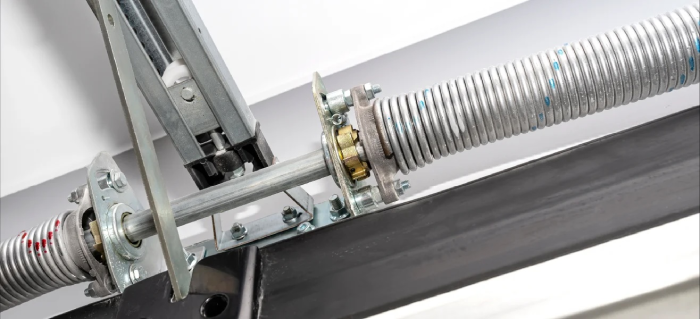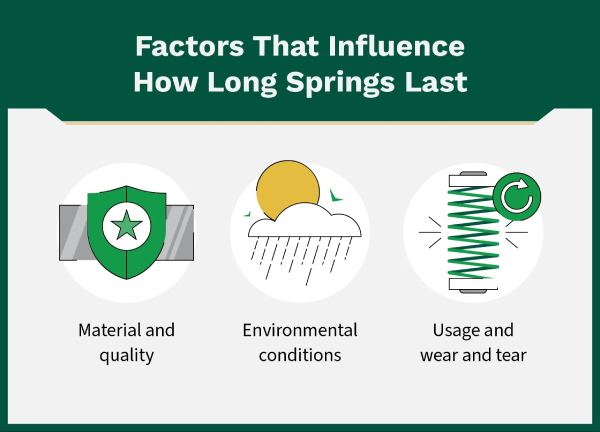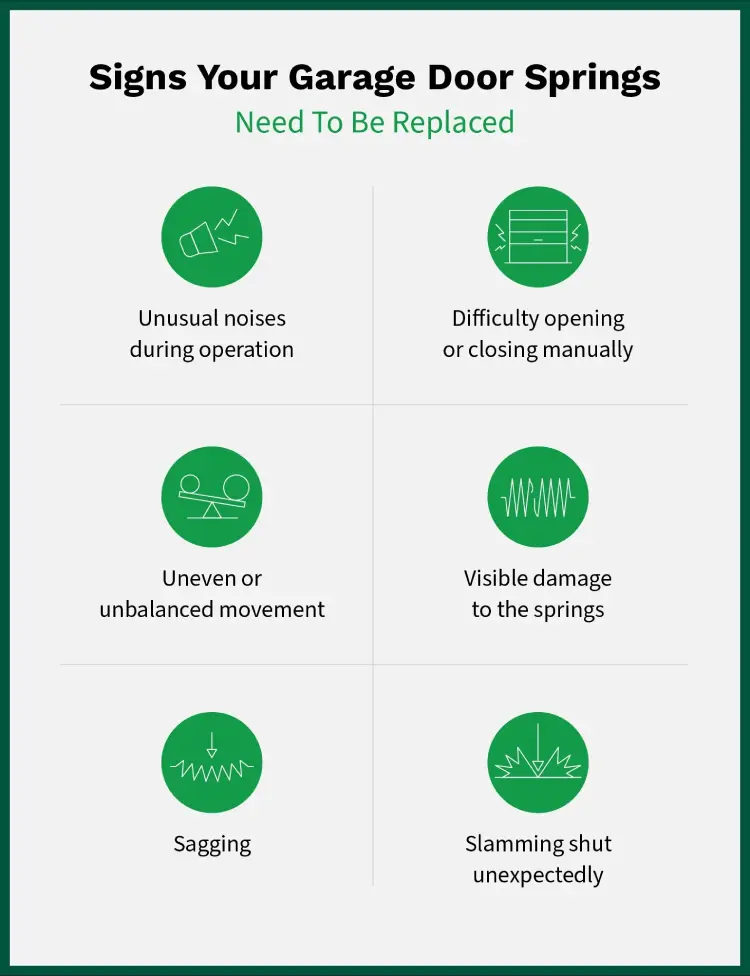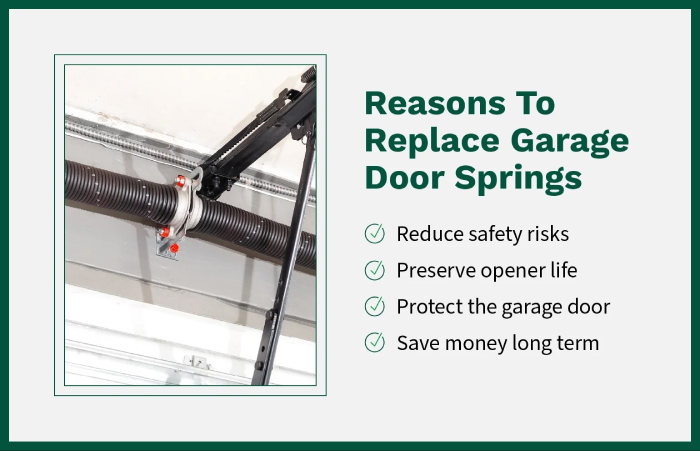
Do your garage door springs seem to have lost the spring in their step? Have you been asking yourself if it’s time to replace them and how long garage door springs even last?
Garage door springs usually need replacing less than every decade. Not replacing the springs can cause the door to fail — sometimes suddenly — and come crashing down. Avoid injury and damaging your property with timely garage door spring replacement.
Understand common factors that influence garage door spring lifespan, signs it’s time to replace them, and more reasons why you should do it sooner rather than later.
Table of Contents:
- What Is the Lifespan of a Garage Door Spring?
- Why Do Garage Door Springs Break?
- 6 Signs It’s Time To Replace Your Springs
- Benefits of Replacing Garage Door Springs
- Let a Professional Safely Replace Your Garage Door Springs
- Garage Door Spring FAQ
What Is the Lifespan of a Garage Door Spring?
The average garage door spring lifespan is seven to 10 years or approximately 10,000 opening and closing cycles. You can maximize the lifespan of your spring with regular maintenance. The lifetime also varies by spring type and quality. For example, when comparing torsion versus extension springs, torsion springs generally last longer.
Torsion spring lifespan
Torsion springs generally last slightly longer than extension springs. Due to how they are constructed, they experience less tension. Because torsion springs twist, the force is more evenly distributed, reducing wear. This design, along with fewer moving parts when compared to extension springs, contributes to a longer lifespan for torsion springs.
Extension spring lifespan
With an average of seven years, extension springs have a shorter lifespan than torsion springs. Similar to torsion springs, the quality of the metal used and the weight of the garage door influence how long they'll last.
The constant pulling force they endure with each opening and closing cycle weakens the metal faster. Homeowners should be extra vigilant for signs of wear, such as a sagging door or a slow-moving opener.
Never attempt to replace garage door springs yourself — consult a Precision Garage Door Service™ professional for inspection and potential replacement.

Why Do Garage Door Springs Break?
Garage door springs endure a lot of stress with each opening and closing cycle. Not only do springs weaken over time with continual usage, but the materials and environmental conditions will also play a role in how quickly they wear.
Material and quality
Most springs are made from high carbon steel wire, but there are variations in quality. Standard springs use basic high carbon steel, which works well but may not last as long. Oil-tempered springs undergo a special heat treatment process that makes them more durable.
Another important factor is wire thickness. Springs with thicker wire can withstand more cycles before succumbing to metal fatigue. This is because the thicker wire distributes stress more evenly. However, thicker wires also add weight to the spring, requiring a stronger motor to operate the garage door. So, it's important to choose springs with the right balance of wire thickness for the specific door weight.
Environmental conditions
Extreme temperatures and moisture can be detrimental to garage door springs. For example:
- High temperatures may weaken the metal in the spring, making it more prone to breakage.
- Cold temperatures can make the metal more brittle, making the springs more susceptible to cracks and sudden failure.
- Moisture exposure will eventually cause corrosion, which weakens the metal, reducing the spring's lifespan.
- High humidity or frequent rain or snow might cause springs to deteriorate faster.
Usage and wear and tear
The more cycles the springs endure, the faster they wear out. This is because each cycle puts stress on the metal, causing tiny tears and weakening it over time. Heavier garage doors naturally put more strain on the springs to lift and lower them.
Beyond these, any situation that puts excessive pressure on the springs can accelerate wear and tear. For example, a malfunctioning garage door opener that shakes the garage door or a storm with strong winds can damage the springs. Proper maintenance, such as lubrication and keeping the door balanced, can help minimize wear and tear and extend the lifespan of the garage door springs.

6 Signs It’s Time To Replace Your Springs
If your garage door is used frequently or is approaching the seven-to-10-year mark, keep a close eye out for signs that it may be time to replace the springs. While many signs will be obvious, such as rust or cracks, others may be less obvious.
Signs that it’s time to replace garage door springs include:
1. Unusual noises during operation
A noisy garage door during operation can be a warning sign that the springs are nearing the end of their lifespan. Be attentive to these sounds, as they can indicate a potential safety hazard and should raise concern:
- Loud popping: This is a classic sign of a broken torsion spring and requires immediate attention by a professional.
- Scraping or grinding: Indicative of worn rollers or a misaligned track, these sounds may also signify a failing extension spring that's no longer properly supporting the door's weight.
- Squeaking or screeching: High-pitched noises in your garage door spring are often caused by a lack of lubrication. Persistent squeaking could also point to failing springs that are putting extra pressure on other components.
2. Difficulty opening or closing the door manually
Feeling increased resistance when manually opening or closing your garage door is a strong indicator that the springs might be worn out. Garage door springs counteract the weight of the door, assisting in lifting and lowering it. When the springs are new and functioning properly, they provide the necessary tension to balance the door's weight. This makes it relatively easy to move the door manually.
As springs age and weaken due to metal fatigue, they lose their ability to counter the door's weight effectively. This translates to increased effort required to lift or lower the door. If it’s a struggle to manage the door manually, it's a clear sign the springs aren't providing sufficient support and likely need replacement.
3. Uneven or unbalanced movement of the door
Uneven distribution manifests as a noticeable tilt or wobble in the door. For instance, one side of the door might be lagging or rising faster than the other. In severe cases, the door may even scrape against the opening or struggle to stay level at all.
These uneven door movements are a sign that the springs are failing to properly support different sections of the door, putting additional strain on the entire system and posing a safety hazard.
4. Visible damage to the springs
Visible damage to garage door springs is a clear signal that they're worn out and require immediate attention. Unlike some of the subtler signs, these visual cues provide a definitive reason for concern:
- Cracks: Over time, metal fatigue can cause cracks to develop on the surface of the spring. These cracks can worsen and eventually lead to a complete break, potentially causing the door to come crashing down.
- Rust or corrosion: Exposure to moisture will eventually lead to rust and corrosion on the springs. This weakens the metal and significantly reduces its lifespan. Look for signs of rust discoloration or flaking on the spring's surface.
- Physical gaps: In torsion springs, a visible gap between coils points to a broken spring. This gap won't be present in a healthy spring, as the coils are tightly wound together.
- Discoloration: While not as concerning as cracks or rust, significant discoloration on the springs might also be a sign of aging and potential weakening. This is especially true if the springs were originally bright and shiny and now appear dull or gray.
5. Sagging
A sagging garage door is a telltale sign that garage springs are nearing the end of their lifespan and can no longer adequately support the door's weight. When this weakening occurs, the springs lose their ability to evenly distribute the weight of the door, manifesting as a visible sagging in the middle or along one side of the door.
6. Slamming shut unexpectedly
Garage door springs function like counterbalances, assisting the opener in lifting and lowering the door smoothly. When they're new and elastic, they absorb the opener's momentum during the closing cycle, ensuring an even and gentle descent. However, worn-out springs lose this ability due to metal fatigue.
This lack of control translates to the door slamming shut with unexpected force. This slamming motion is not only a nuisance but can also damage the door and the opener motor and potentially cause injury. Stop using a garage door that slams unexpectedly immediately and contact service professionals for an inspection.

Benefits of Replacing Garage Door Springs
Replacing worn-out garage door springs isn't just about maintaining a well-functioning door; it's crucial for safety and preventing further damage.
- Reduces safety risk: Broken springs can cause the garage door to come crashing down unexpectedly, posing a serious risk of injury to anyone or anything underneath. Additionally, a malfunctioning door with weak springs can be more easily forced open, compromising home security.
- Preserve opener life: A struggling opener due to weak springs has to work harder to lift and lower the door. This extra strain will eventually lead to premature wear and tear on the opener motor, potentially shortening its lifespan and requiring a costly replacement.
- Protects the garage door: A sagging door caused by weak springs puts stress on the entire structure, including tracks, rollers, and hinges. Over time, this strain will likely lead to misalignment, warping, and even broken door panels.
- Saves money long term: While the upfront cost of replacing springs may seem like an extra expense, it pales in comparison to the potential costs of injuries, a damaged door, or a burnt-out opener motor.
Let a Professional Safely Replace Your Garage Door Springs
If you’ve noticed any of the wear and tear signs of a garage door spring or it’s simply been seven to 10 years since you installed them, consider having the professionals at Precision Garage Door Service examine your garage door. We can help diagnose the issue, provide possible solutions, and complete repairs and replacements.
Contact Precision Garage Door Service to learn more about garage door spring replacement.
This article is intended for general informational purposes only and may not be applicable to every situation. You are responsible for determining the proper course of action for your property. Services should be performed by licensed and experienced professionals. Precision Garage Door Service is not responsible for any damages that occur as a result of this blog content or your actions. For the most accurate guidance, contact a Precision Garage Door Service professional for a comprehensive on-site assessment.
Garage Door Spring FAQ
Precision Garage Door Service professionals are experts in repairing and replacing torsion and extension garage door springs. And because our service professionals are trained and field tested by the best in the industry, we have encountered many questions you may be wondering about, too. If your question isn’t listed here, be sure to reach out to us.
Is it common for garage door springs to break?
Yes, garage door springs do commonly break and need to be replaced an average of every 8.5 years or 10,000 opening and closing cycles. After years of use and exposure, the constant stress they’re under weakens them.
How do I know if my garage door spring is worn out?
There may be visible signs, such as cracks and rust, as well as unusual noises, sagging, or uneven movements. All of these can indicate that the springs are wearing out and should be addressed by a professional.
How can I make my garage door springs last longer?
To extend the lifespan of garage door springs, avoid unnecessary opening and closing. Regularly lubricate the moving parts of the garage door system to reduce friction. Regularly schedule professional maintenance and inspections to identify and address any signs of wear before they become more serious.
How much does a spring cost for a garage door?
The average cost to replace garage door springs is $250. The cost varies depending on several factors, including whether both springs need to be replaced (usually recommended), the type of springs, and the urgency of the replacement.
Can I replace my garage door springs myself?
No, do not attempt to handle garage door spring replacement yourself. Because the springs are under high tension, garage door spring replacement should be handled by professionals.